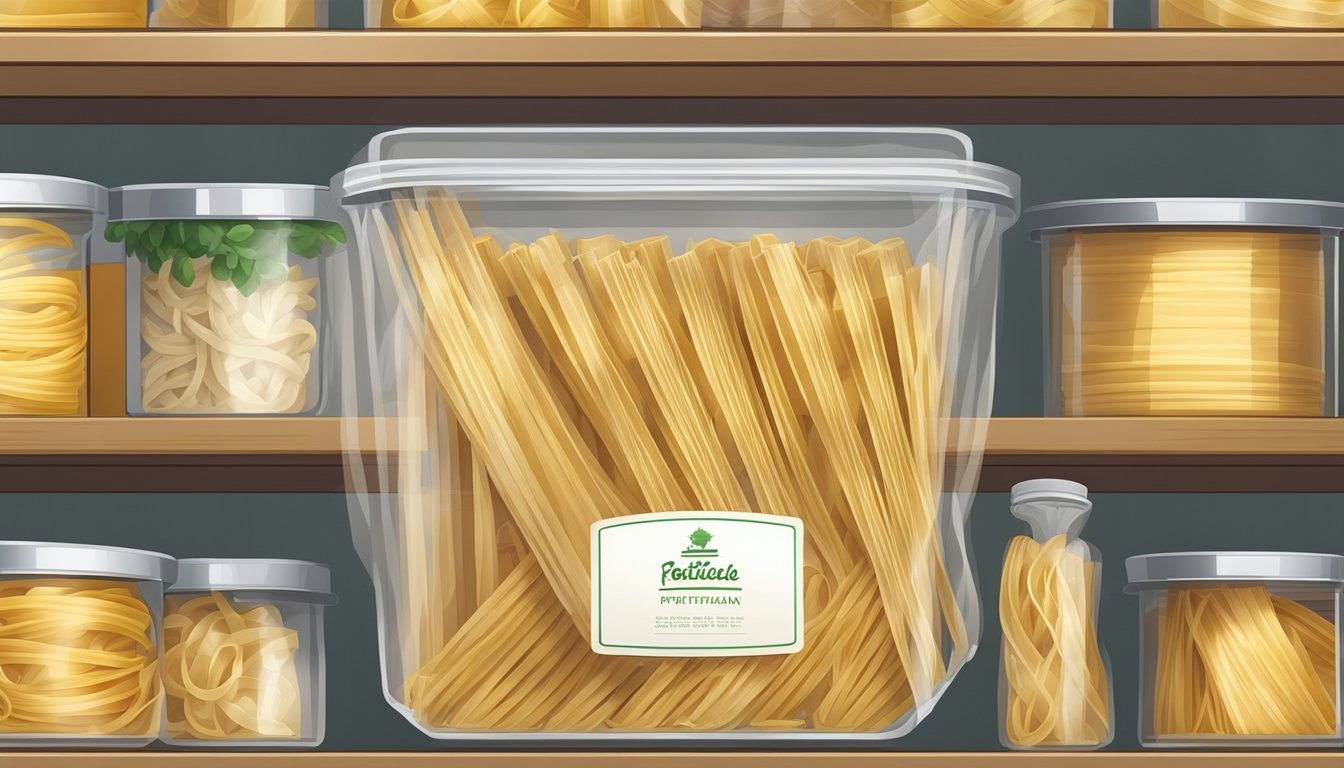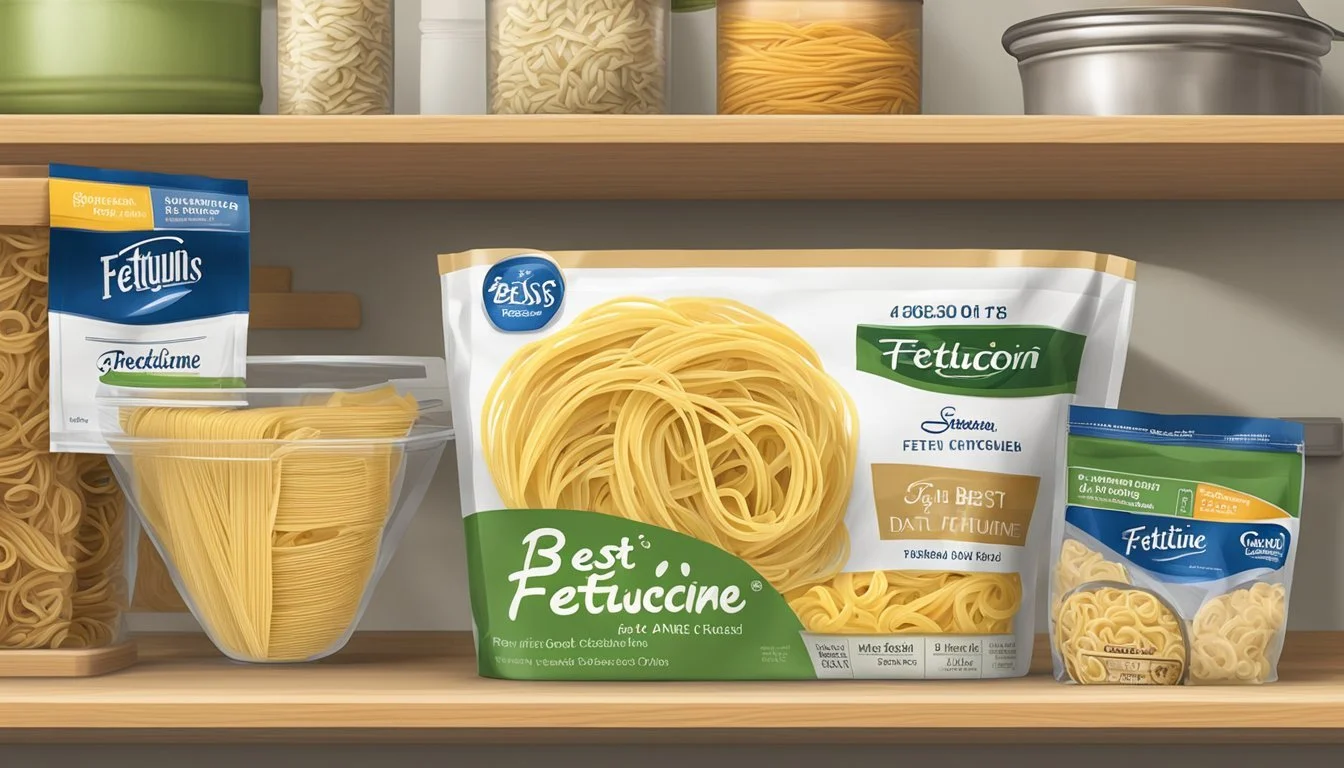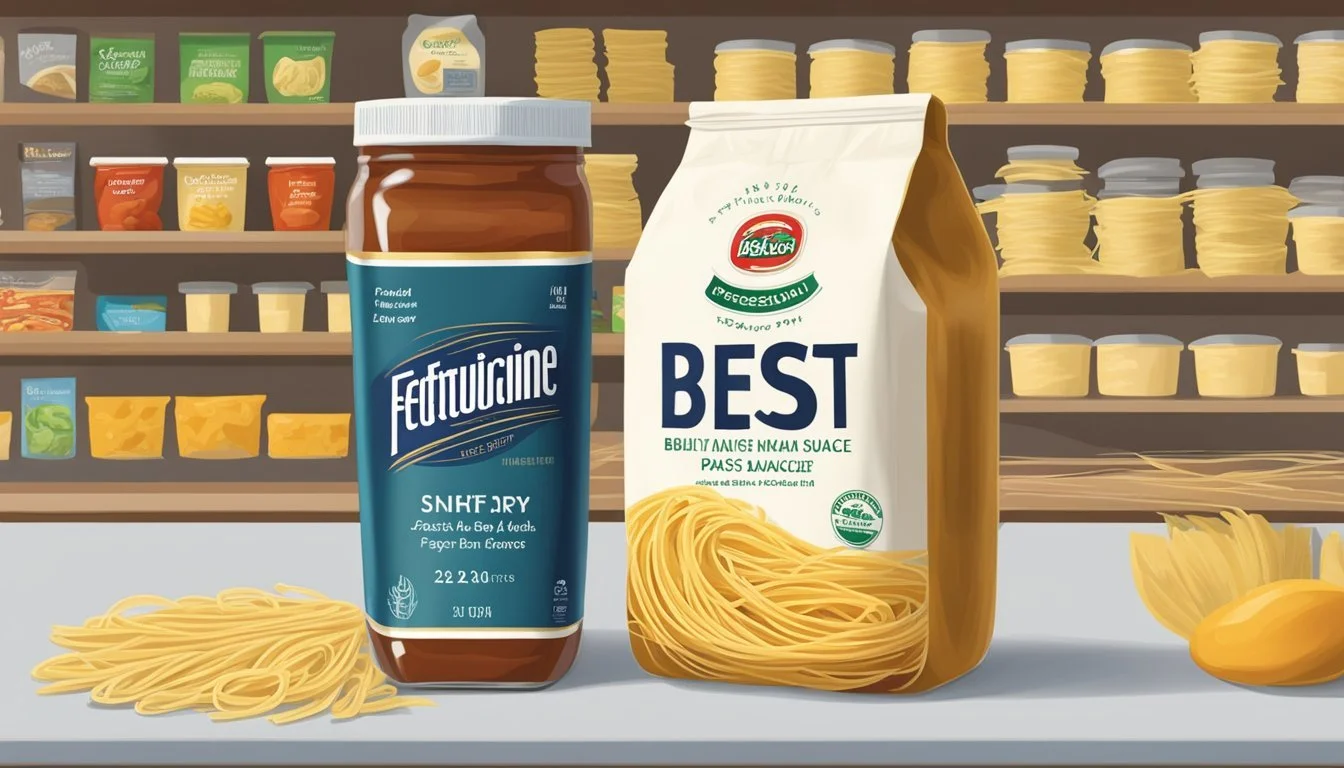How Long Does Fettuccine Pasta Last?
Shelf Life and Storage Tips
Fettuccine pasta, often enjoyed for its hearty texture and ability to hold robust sauces, is a staple in many pantries. Understanding its shelf life is essential for both quality and safety reasons. Dry fettuccine pasta (What wine goes well with pasta?), when stored properly in a cool, dry place, typically maintains its quality for about 1 to 2 years due to its low moisture content. It should remain in its original packaging or a sealed container to maximize freshness. The expiration date on the package can also serve as a guideline, though pasta may remain safe to eat beyond this date if it has been stored correctly and shows no signs of spoilage.
The shelf life of fettuccine alters significantly once it is cooked. Refrigerated cooked fettuccine should ideally be consumed within 3 to 5 days to enjoy its best quality and to ensure food safety. To extend its usability, cooked fettuccine can be frozen where it retains quality for 1 to 2 months. Each of these time frames assumes the pasta has been stored under ideal conditions and shows no signs of deterioration.
Fresh fettuccine, which contains added moisture and sometimes eggs, has a markedly shorter shelf life. It should typically be used within 4 to 5 days if kept in the refrigerator. Freezing fresh fettuccine extends its shelf life to about 1 to 2 months. Care should be taken to store fresh pasta (how long does fresh pasta last?) in air-tight containers or freezer bags to prevent freezer burn and the absorption of other flavors and odors.
Types of Pasta
Understanding the various pasta types is essential for proper storage and optimal taste.
Dry Pasta
Dry pasta has a long shelf life due to its low moisture content, commonly ranging from one to two years in a cool, dry place. It's made from durum wheat and water, making it hard and suitable for long-term storage.
Fresh Pasta
Fresh pasta is made with eggs and flour, contributing to a shorter shelf life due to higher moisture content. It typically lasts for one to two days in the fridge and, if bought pre-packaged, may last up to six or seven days as indicated by the expiration date.
Cooked Pasta
Once dry or fresh pasta is cooked, it should be consumed within three to five days when stored in the refrigerator. Leftovers should be covered in an airtight container to maintain quality.
Stuffed Pasta
Stuffed pasta, like ravioli or tortellini, has fillings that can include meat, cheese, or vegetables. This type requires refrigeration and usually lasts for three to five days in the fridge due to the perishable ingredients in the stuffing.
Gluten-Free Pasta
Gluten-free pasta, replacing wheat with alternative flours such as rice or corn, typically mirrors the shelf life of traditional pasta, with dried versions lasting up to two years and cooked gluten-free pasta lasting three to five days refrigerated.
Homemade Pasta
Homemade pasta has a freshness that store-bought pasta cannot match, yet its shelf life is shorter. It can last in the fridge for about one to two days. If it contains perishable ingredients like eggs, it's essential to store it properly to avoid spoilage.
Determining Pasta Shelf Life
When stored properly, fettuccine pasta shelf life varies based on whether it's dry or fresh. The label and expiration date are initial indicators of longevity, while a visual and olfactory assessment of the pasta's condition can reveal more about its usability.
Label and Expiration Date
Manufacturers provide a "best by" or expiration date on their pasta products as a guide for optimal quality. For dry fettuccine pasta, this date typically extends 1-2 years past the purchase date. However, it's crucial to distinguish between a "best by" date, which suggests when the pasta is expected to be at its best quality, and a true expiration date, after which the pasta may not be safe to consume. Fresh fettuccine pasta, on the other hand, comes with a much shorter shelf life, usually 4-5 days after the "best by" date when refrigerated.
Assessing Pasta Condition
Storage conditions directly affect pasta's longevity. Dry fettuccine should be kept in a cool, dry place such as a pantry to maximize its shelf life. If stored correctly:
Dry pasta should remain free from mold and discoloration.
Fresh pasta, which is more perishable, must be refrigerated and consumed quickly to avoid spoilage.
To assess pasta's condition past the "best by" date, one should:
Check for any signs of mold, typically appearing as fuzzy spots that can be green, white, or black.
Look for discoloration or a dull appearance, which may indicate deterioration.
Smell the pasta. An off or sour odor indicates the pasta is no longer good to eat.
One should always inspect pasta closely regardless of the date printed on the package, as actual pasta shelf life can be influenced by factors such as exposure to moisture or contaminants.
Proper Storage Methods
Proper storage methods for fettuccine pasta significantly extend its shelf life and retain its quality. Each form of pasta, whether dry, fresh, or cooked, has a specific storage technique that optimizes its longevity.
Storing Dry Pasta
To store dry fettuccine effectively, one should place the pasta in an airtight container or a sealable plastic bag. It is crucial to ensure that the pasta is kept in a cool, dry place such as a pantry or cupboard, away from direct sunlight and sources of heat. This prevents exposure to moisture and temperature fluctuations that can compromise the pasta's texture and taste.
Ensure a steady temperature: ideally between 60-75°F (15-24°C)
Minimally exposed to light and air to prevent degradation
Refrigerating Fresh and Cooked Pasta
Fresh fettuccine should be stored in the refrigerator and is best if consumed within a few days. An airtight container is essential to protect it from moisture and other flavors in the fridge. The oil content in fresh pasta acts as a natural preservative but also makes it prone to rancidity if stored improperly. Cooked pasta can last in the refrigerator for 3-5 days when stored properly.
Fresh pasta: refrigerate in an airtight container and consume within 1-3 days
Cooked pasta: refrigerate in an airtight container and consume within 3-5 days
Freezing Pasta
Freezing is a viable option for extending the shelf life of both fresh and cooked fettuccine. To freeze fresh fettuccine, one should dust it with flour to prevent sticking, then place it in a single layer on a baking sheet to freeze initially. Once frozen, transfer the pasta to an airtight container or a freezer bag. Cooked pasta should be cooled before being stored in the freezer. It can last for 1-2 months if frozen properly.
Fresh pasta: freeze on a baking sheet, then store in an airtight container or freezer bag
Cooked pasta: cool thoroughly, then freeze in an airtight container or freezer bag
Factors Influencing Longevity
The shelf life of fettuccine pasta is affected by several controllable conditions. Understanding these factors ensures proper storage and maximum longevity.
Moisture and Humidity
Exposure to moisture can significantly reduce the shelf life of fettuccine by creating an environment for bacterial growth. It's essential to store dry fettuccine in a cool and dry place. For fresh pasta, which contains more moisture, refrigeration is necessary to prevent spoilage.
Temperature and Light
High temperatures can cause fettuccine to deteriorate, while exposure to light can lead to loss of color and off-flavors. Store fettuccine in a dark, cool environment, away from direct sunlight and heat sources to maintain its quality.
Packaging and Containers
Proper packaging and containers are critical in preserving fettuccine's freshness and extending its shelf life. Air-tight containers or vacuum-sealed bags prevent exposure to air and contaminants. Ensuring that the packaging is intact and properly sealed also helps in retaining pasta quality.
Food Additives and Ingredients
The composition of fettuccine impacts its longevity. Additives may extend shelf life, while the presence of ingredients like eggs and oil in fresh pasta shortens it. Dry fettuccine, mainly made from wheat, typically lasts longer as it contains less moisture and perishable components.
Safety and Spoilage Indicators
When assessing whether fettuccine pasta has surpassed its prime for consumption, certain indicators must be carefully observed to ensure safety and avoid foodborne illness.
Visual and Olfactory Signs
One should inspect the pasta for any changes in color, such as discoloration or darkening. Fettuccine should maintain its even, cream-like color. If there are any signs of yellowing or grayish hues, this may indicate spoilage. The presence of an off-putting smell is a clear sign that the pasta should not be consumed. Fettuccine pasta that is fresh should not have any noticeable smell.
Mold and Bacterial Growth
The presence of mold, which may appear as fuzzy spots of various colors including white, green, or black, is an unequivocal indication that the pasta is unsafe to eat. With fettuccine being a perishable food, it can foster bacterial growth if stored improperly or kept for longer than recommended. Mold or bacterial growth on pasta can lead to food poisoning and should be taken as a serious sign of spoilage.
Usage and Consumption
Fettuccine pasta's shelf life, flavor, and texture are significantly influenced by the way it's cooked and stored. Proper usage during these stages is crucial for maintaining quality.
Cooking Recommendations
When cooking fettuccine, an ideal practice is to aim for the 'al dente' texture, which means the pasta should be cooked through but still firm to the bite. This not only ensures optimal flavor and texture but also affects how the pasta holds up in leftovers. Regardless of whether one is making fettuccine alone, penne, lasagna, or spaghetti bolognese, ensuring not to overcook the pasta is key, as overcooking can lead to a mushy texture when reheated.
Cook time: Follow package instructions, typically 8-12 minutes.
Water: Use a large pot with plenty of boiling water.
Salt: Add salt to the water for enhanced flavor.
Reheating and Leftovers
Leftover fettuccine should be stored properly to retain its taste and texture. Refrigeration is the best way to keep cooked pasta fresh; it can last up to five days if stored in an airtight container. When reheating, one can add a small amount of water or sauce to prevent the pasta from drying out and to help reclaim the al dente texture.
Storage: Keep leftovers in a tightly sealed container in the refrigerator.
Reheating: Use a microwave or stove with added moisture to refresh the dish.
Remember, reheated fettuccine may have a slightly different texture from when it was first cooked, but proper reheating methods can preserve much of the flavor and enjoyment of the dish.
Pasta Preservation Tips
Proper storage methods ensure both freshness and extended shelf life for fettuccine pasta, whether it is dry or freshly made. Implementing these techniques will maintain the quality and safety of the pasta.
Maximizing Freshness
To maintain the freshness of fettuccine pasta, it's crucial to keep it away from factors that cause degradation. Fresh fettuccine pasta, in particular, is perishable and should be used within three days if stored in the refrigerator. For optimal freshness, store it in an airtight container or a sealed plastic bag to prevent exposure to air and moisture. Whole wheat pasta should also be kept in a cool, dry place to preserve its quality. If immediate use is not planned, one can freeze fresh fettuccine. Lay the pasta flat on a baking sheet to freeze, then once frozen, transfer it into a freezer bag or container. Freezing can extend the life of fresh pasta considerably, typically up to three months.
Extending Shelf Life
Dry fettuccine pasta boasts a longer shelf life, remaining edible for up to two years when stored correctly. To extend its shelf life, keep dry pasta in a dry, cool cupboard away from any heat sources, in an airtight container or original packaging. To mitigate spoilage risks, ensure that your storage environment is less prone to humidity and temperature fluctuations. Vacuum-sealing dry pasta with an oxygen absorber can dramatically increase its longevity, allowing safe consumption for many years. When considering pasta storage solutions, one might opt for a vacuum-sealing food preservation machine to achieve the best results for long-term storage.
Troubleshooting
As consumers evaluate their fettuccine pasta's edibility and safety, two primary concerns arise: the risks associated with expired pasta and the prevention of pests and contamination. Properly addressing these issues ensures both food safety and the enjoyment of high-quality noodles.
Expired Pasta Risks
Expired pasta, especially when improperly stored, poses several food safety risks. While shelf-stable dry noodles like fettuccine can last beyond their expiration date without significant health dangers, their texture and flavor may degrade. On the other hand, fresh pasta like tortellini is more perishable and can harbor harmful bacteria past its expiry. It's crucial to inspect pasta for any signs of spoilage, such as off-odors or discoloration, before consuming.
Signs of Spoilage:
Odor: Musty, sour, or any other abnormal smells.
Visual: Mold, discoloration, or any unusual appearance.
Texture Change: Pasta should maintain its original firmness; if it becomes overly hard or shows signs of deterioration, it's time to discard.
Preventing Pests and Contamination
To maintain the longevity and safety of pasta like fettuccine and to a lesser extent, beans, which are also shelf-stable, preventing pests and contamination is imperative. Proper storage in an airtight container in a cool, dry place is essential for deterring pests like weevils or pantry moths that can infest pasta products.
Storage Recommendations:
Use airtight containers to protect from pests and moisture.
Keep in a cool, dry place to avoid humidity that encourages bacterial growth.
Regular Checks: Regularly inspect pasta and other similar pantry items for signs of pest activity or spoilage, and clean the storage area to reduce contamination risks.







